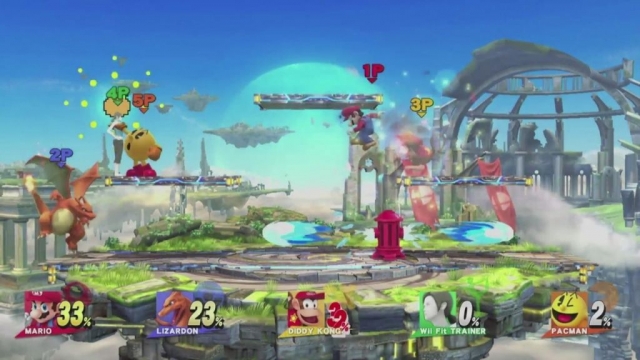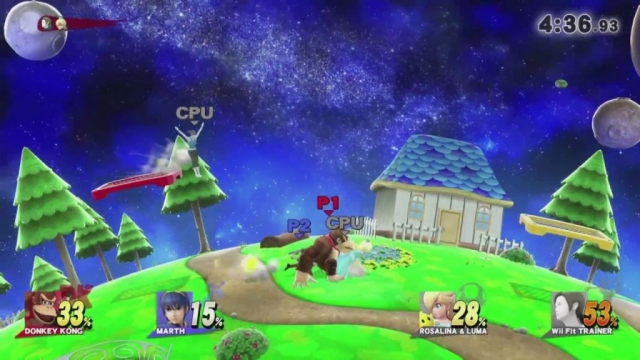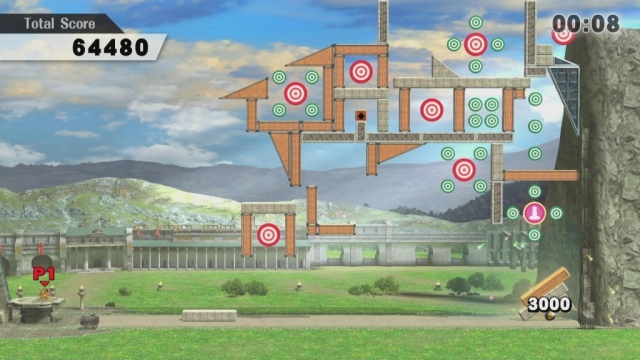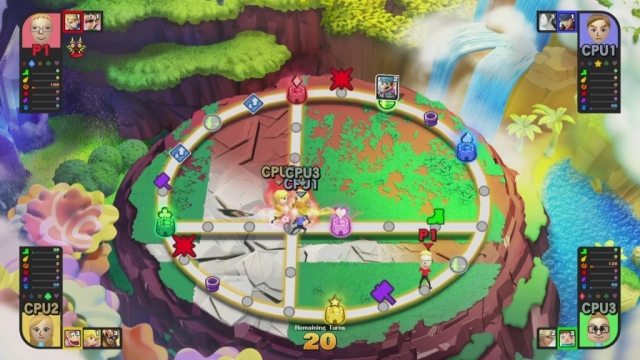Super Smash Bros. Wii U
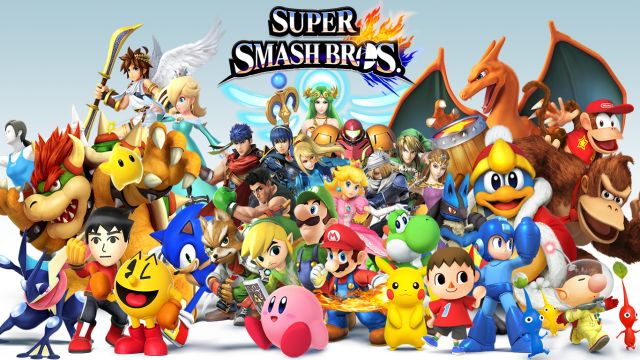
For 15 years, the Super Smash Bros. series has had one of the most interesting stories in gaming. This hasn’t been due to a compelling plot, but because it went from being a side game that flew under the radar to become one of gaming’s biggest and most revered franchises. The series began in 1999 on the N64 and was such a low profile release that its Japanese release would just get a quick mention in passing in EGM, while advertising was limited to print. Like Goldeneye on that very same platform, word of mouth spread and the game quickly became a destination for anyone with an N64. The fighter-lean system wound up with one of the greatest fighters of all-time on it.
Melee succeeded it in 2002 and brought the series to the Gamecube with more hype. Now, Nintendo knew they had something special on their hands and sped things up while greatly expanding the roster from eight to 26 and throwing in nearly 30 stages. The long-form platforming Adventure mode mixed things up, while the gauntlet-style All-Star mode tested the skills of all who dared challenge it. In-game trophies also made their debut and became a staple for the franchise.
Brawl hit the Wii in 2008 and blew people away. It had a legendary roster with 39 characters including third-party icons like Sonic the Hedgehog and Solid Snake, and debuted the Subspace Emissary that expanded upon the Adventure mode with character-specific storylines. The biggest gameplay change was the slowing down of the overall action in an effort to expand the fandom and make it more user-friendly. This particular issue led to a split fanbase, but also the easy-to-install Project M hackless mod that brings back several Melee characters and speeds up the gameplay. The base game featured new online play, as was a vault area that allowed you to play demos of full classic games available on the eShop.
It’s taken 15 years, but the fourth console entry (coming shortly after the first portable entry), is now upon us. It’s amazing to see a franchise game in 2014 not be something that’s been beaten into the ground, In the time since just the release of Brawl, we’ve had over a dozen Assassin’s Creed games of various types on several kinds of platforms. It’s a staggering statistic, but one that shows the value in crafting something with great care as every entry in the Smash series is worth playing for years after its initial release, thus making it one of gaming’s better values.
Super Smash Bros. For Wii U is easily a must-have game and one that is worth buying the system for – alongside Mario Kart 8. While it removes the character-centric emissary mode, you have so much other variety that it’s honestly not something I noticed until running down modes and comparing the franchise game-by-game.
The regular arcade-style mode is back, alongside a ton of new modes. Added for this entry are Special Order modes where you tackle challenges set forth by Master and Crazy Hand. With each, you’ll have to endure special battles that are meant to tax your skills and then wear you down for a battle with the respective boss. The more fights you take on, the greater the rewards, but you’ll stand a worse chance of winning since damage carries over to some degree. It’s an addictive mode and a great way to unlock new moves and other little goodies.
Smash Bros succeeds at incentivizing nearly every fight you’re in with some kind of unlockable thing. It might be a piece of art or an item, but you may even unlock a new technique for a custom fighter. Speaking of which, that’s something new for this game. You can make a Mii and place yourself in the battle, or change up an existing roster member for the first time ever. If you want to make someone more like a past version of themselves, you can do it here. Stage creation is also back and makes full use of the gamepad for easier placement of the environmental pieces and items. It’s a little tough to fully construct something on the standard-def screen though, so while the ease of use has gone up in one area, it’s gone down in another.
Fighter creation is something that will get a lot of use as time goes on and people unlock everything. The big appeal here is having Miis do battle, and you can keep them as they are or change them up with custom outfits. The three main character types are available, so if you want a grounded brawler kind of like Little Mac, you can, or you can go with a long-range gunner ala Samus or a swordfighter like Link and Shulk from Xenoblade Chronicles.
New to this game are stadium events. You can swing a bat and toss Sandbag around for some quick fun. Target smash has gone from being a side-scrolling platformer into being an Angry Birds clone. Surprisingly, this works out very well. Instead of using a variety of birds, you’ve got a time bomb and you need to figure out how to best time it to have the maximum blast radius and start a chain reaction too. While it is a slightly disappointing change in the concept in theory, I love the bomb’s timer since you really do need skill to excel. The most replayable stadium event is the new horde mode. There’s a ton of variety with it as you can fight 10 foes, 100, fight for three minutes, or go with an endurance setup where you fight for as long as you can survive. The time limit vs. no time limit aspect reminds me a lot of the console Crazy Taxi games, but without The Offspring or late ’90s ‘tude.
Events mode is another new attraction and it’s basically a fight tree set up like a skill tree where beating one battle unlocks a new one, and perhaps even a new fork in the road for a path of fights. You’ll do battle with the fastest fighters in the game, fight four Toon Links in a sendup of Four Swords Adventures and tackle the biggest fighters in the game in one fight too. It’s a challenging mode, but one that pays homage to history while providing modern-day fun.
Smash Tour combines the brawling aspect of the game with a board game akin to Mario Party or Fortune Street. You can play in either solo or group play and take turns with everyone moving whatever space amount they get and then hopefully landing on either a checkpoint for a big points gain if you hit all of them or getting an item. Items can increase the power of your fighters, and wins during battles can get you more fighters, or you can wind up with none after a big loss. There are a variety of boards to play on and even boss battles to tackle for massive points as well. This may not be everyone’s cup of tea, but it easily my favorite mode in the game and something I enjoyed more than any of the prior adventure modes.
The core fighting is as good as ever, with fast-paced combat that makes good use of each roster member. There are a ton of control options and I was quite surprised to see that the Gamepad was so comfortable. The hand grips definitely make longer play sessions easier, while the Wii’s classic controller pro is a blessing too. Sadly, online is a bit of goose egg for the game. It’s shockingly laggy and while I’m sure that’s something they’ll iron out in time, it feels really half-baked and is easily the game’s weakest point.
Visually, this is a stunning game and a fine example (alongside just about every first-party game) of what the Wii U’s hardware is capable of. Character models have more detail than ever before, and the animation is smooth too. Snapshot mode is back and allows for mid-battle shots, but with a new feature – painting! You can alter any photo you take with the Gamepad and add things like wings or even make a mural to one of the characters.
Audio-wise, this really goes above and beyond. You can really tailor the in-game soundtrack to suit your needs and personalize it. You choose which version of a game’s theme plays, for example, and then set it to either play a lot or a little bit. This is basically the dream game when it comes to Nintendo-related songs, and the remixed versions of classic songs are always fun to listen to just to hear how much you can change a song while keeping its soul intact. The usual cartoony sound effects are retained, as is the boisterous announcer.
Super Smash Bros. for Wii U is the best overall entry in the series and another game that’s worth owning a Wii U for. Online play is really iffy, but every other part of the game is an absolute riot to play. It’s got a ton of modes and they’re all fun, with Smash Tour blending board and fighting games far better than one could realistically expect. Anyone who has loved prior entries will fall in love with this, and if you’re a lapsed fan, you’ll be reminded of why you loved the series.
Reviewed By: Jeremy Peeples
Publisher: Nintendo
Rating: 95%
——————————————————————————–
This review is based on a retail copy of Super Smash Bros. for the Wii U purchased by the reviewer.
 Game Over Online
Game Over Online